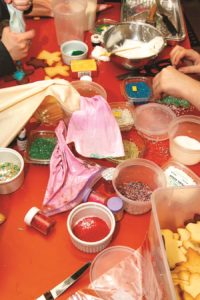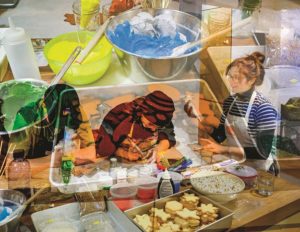Christmas movie marathons, finding the pickle ornament hidden in the tree, folding tamales, regifting fruitcakes — the holidays inspire all kinds of traditions. For almost 20 years, our son, Asher, and his three best friends, Eva, Edy, and Caroline, have spent the afternoon of Christmas Eve in our kitchen decorating cookies.
We’re the kind who watch the Great British Baking Show as a family. We love how the contestants express their humanity through sugar. And how the key ingredient in each recipe is the person making it.

I worry when I see signs that holiday baking is being swept into the “step up your game” tyranny of the domestic diva-industrial complex, where an army of Instagram influencers, using icings as armaments, can make you feel defeated before you’ve had a chance to cast the first sprinkle. But if you think kids buy into this neat ideal, you need a wake-up toddy.
Our annual ritual began as a way to distract Asher and friends while I prepared for our grown-up Christmas Eve party. It evolved into the heart of our holiday.
Back then, I baked sugar cookie stars, trees, and gingerbread people. I set up small dishes of colorful sanding sugars and rainbow sprinkles and poured icings into squeeze bottles sized for their small hands. Then I gave each fidgety child an apron and let them play.
I showed them a few tricks: how to outline a cookie in icing (“Just let it fall easily, like a rope”) and how to flood inside the lines using thinner icing to coat the cookie. They decorated with finger-painting freedom, giggling at their designs while nibbling on the toes of gingerbread people. Sprinkles spilled, icing ran — it was barely controlled cookie chaos.
Over the years, as their dexterity developed, I showed them how to drag a toothpick through a dot to make a heart, or through a spiral of frosting to make a starburst, and through straight lines to make chevrons. My husband’s pictures of this annual event are our notches on a door jamb marking school years, growing up, coming out, leaving home, and coming back.
These four friends have bloomed into adulthood, off to different colleges and careers. They have found themselves in new cities, changed pronouns, been through breakups, and yet they remain constants in each other’s lives. Every Dec. 24, the text messages go back and forth asking, “What time are we cookie decorating?”

Eva’s cookies are artful; her patience and quiet attention to detail turn a blank disk into a beautifully articulated Earth. Asher makes mustached, ungendered angels, and irreverently decorated cats. Caroline’s humor comes through in the cookie portraits she makes of the group. Edy admits to being the “weak link” when it comes to decorating but provides commentary with the timing of a seasoned stand-up comic.
Then there was Covid. Parties got canceled, trips postponed, events distanced. It was Caroline’s “This tradition is a constant” that reminded us this was too important to miss. I dropped off kits — with cookies, colored icings, sprinkles, dragées, and candy mustaches — at each of their apartments. They decorated over Zoom.
We are still not ready for a big gathering, but this year I know they will be decorating together again. Even though they have grown up, their playful joy persists.
The way I see it, there are two categories of holiday cookies — those that are for eating and those that are canvases for decorating. It’s a given that cookies should be tasty, but with layers of icing and decorations, some turn into sugar art. For the cookies I want to eat, less is more: a frosting wink, a candy smile, or a simple string of candy pearls on a gingerbread man.
Either way, you can bake from scratch or buy your dough. The same goes for icings. And sprinkles can be special or the supermarket kind. Watch a video and teach yourself to pipe, flood, and dazzle. Or, because life is unpredictable and finite, screw perfection and sprinkle to your heart’s content.
Sugar Cookies
Makes 2 to 3 dozen
This is a good, basic dough for roll-out cut-out cookies. It’s adapted from one I used in my old Food Network test kitchen days. The reason for chilling the dough after rolling it out is that the colder it is, the easier it is to cut shapes.

2 sticks unsalted butter, at room temperature
¾ cup sugar
2½ cups cake flour, plus more for rolling
1 tsp. baking powder
¼ tsp. fine salt
1 large egg
2 tsp. pure vanilla extract
Beat the butter and sugar in a large bowl with a mixer on medium-high speed until light and fluffy, 3 to 5 minutes. Meanwhile, whisk the flour, baking powder, and salt together in a medium bowl, breaking up any baking powder lumps.
Whisk the egg and vanilla together, add to the butter mixture, and mix until smooth.
Reduce the mixer speed to low and beat in the flour mixture in 2 batches until just incorporated.
Divide dough between 2 pieces of parchment or wax paper; shape into flat square. Wrap and refrigerate until firm, at least 1 hour.
Roll out one portion of dough on a lightly floured surface about 1/8 inch thick. Slip onto parchment and refrigerate while rolling out the other portion.
Line two cookie sheets with parchment or a reusable silicone mat. Use your favorite cookie cutter to make 2-to-4-inch cookies, and space them about 2 inches apart on the pans. Gather the scraps and refrigerate until firm; reroll once to cut out more cookies. Refrigerate the cutouts until firm, at least 20 minutes.
Position racks in the upper and lower thirds of the oven, heated to 350o F. Bake, switching the pans halfway through, until the cookies puff, and edges are a pale golden, 12 to 14 minutes. Let set on pans for 5 minutes before transferring to racks to cool completely.
